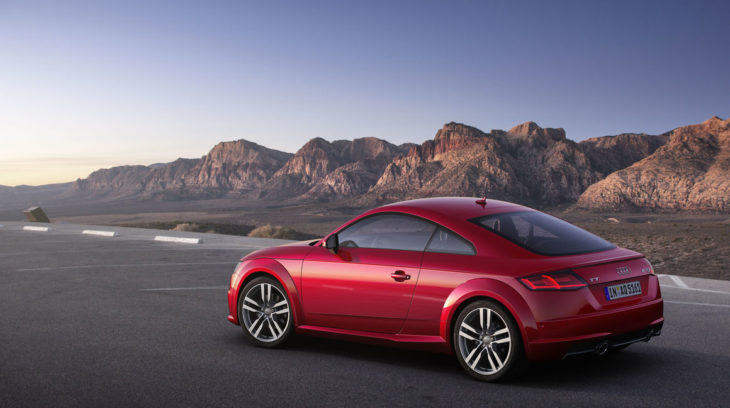Audi TT – History in the Making

The idea of a small, sporty and affordable coupe was first proposed to Audi’s management in 1994 and since the project was extremely well received work on the prototype immediately started at the Volkswagen Group Design Center in California. Only a year later, the first Audi TT concept car made its official world debut at the 1995 Frankfurt Motor Show and, unlike most concept cars, this one was almost identical to what we were about to see entering production three years later, in September 1998.
The final design was created by a team led by famous designers J Mays and Freeman Thomas and who also included a man who was about to become one of the most influential automotive designers of the 2000s, Peter Schreyer. After the TT, he also played a major role in styling the Audi A3, the A4, the A6 and the New Beetle, before leaving Audi for Kia, where he is credited with the company’s impressive design revolution. He was the one to create the South Korean brand’s famous Tiger Nose corporate grille we see today on all of the company’s products.
But why did they call it “TT”?
When it was first introduced, everyone was intrigued by the model’s name, TT, when the German carmaker named all of their models starting with the letter A. It was obvious that TT was short for something, but no one was sure for what (between us, there are still many out there who have no idea what TT stands for).
Well, Audi decided to call the new sports car TT in honor of the famous “Tourist Trophy” motorcycling competition that takes place each year on the “no speed limit” roads of Isle of Man in the United Kingdom. Ok, I get it, but what does motorcycle racing have to do with an Audi sports car?
Well, in 1907, a company called NSU Motorenwerke joined the inaugural edition of the Isle of Man TT, with British manager Martin Geiger finishing fifth on an NSU bike. Four decades later, in the 1950s, NSU bikes became extremely successful in the competition, setting the World Record for speed on four occasions: 1951, 1953, 1954 and 1955.
After being the world’s largest motorcycle producer in the 1950s, NSU started building cars in the early 60’s, producing models like Prinz 1000 and…1000TT and 1000TT/S. The company was then acquired by the Volkswagen Group in 1969 and immediately merged with Auto Union to form Audi NSU Auto Union AG. Later on, TT was also used as the short form of Audi’s motto, “Technology and Tradition”.
First generation Audi TT
The first generation Audi TT had a long career, spanning eight years between 1998 and 2006. The first version to be available, on September 1998, was the Coupe, with the Roadster being launched a year later, in August 1999. The car was built on Volkswagen Group’s PQ34 (A4) platform, which was also used for several other models including the first generation Audi A3, the Volkswagen Golf IV and Bora, the Skoda Octavia, the New Beetle and Seat’s first generation Leon and second generation Toledo.
Despite the production version being ready earlier, market launch was delayed because Audi had several issues implementing a new laser beam welding technology in the production process. This technology was vital to the project as it allowed the German carmaker to manufacture the car’s rounded design that brought so many praises when it was introduced.
The Audi TT was powered by a 1.8-liter turbocharged gasoline engine that was available in several power outputs throughout the model’s production run, including 150, 163, 180, 190, 225 and 240 hp. There was also a 3.2-liter V6 available at one point, that was producing 250 hp and 236 lb-ft of torque (320 Nm), and this version, like all other ones having more than 200 hp, were available with Audi’s quattro all-wheel drive system as standard.
In 2005, a limited edition Audi TT quattro Sport was introduced, receiving a set of weight saving features which made it 165 pounds (75 kg) lighter than a normal TT. To save as much weight as possible, Audi’s engineers removed the spare wheel, the rear seats, the standard air conditioning, the rear parcel shelf and the rear counterweight. And since so many important components were removed, others had to be redistributed, like the battery, for example, which was moved to the rear for balancing the weight distribution.
All these measures, combined with an upgraded version of the 1.8-liter turbo engine that produced 237 hp, allowed the car to accelerate from 0 to 62 mph in 5.9 seconds and reach an electronically limited top speed of 155 mph. The Audi TT quattro Sport was built in a limited run by the German car manufacturer’s high performance “quattro” division.
Tragic high speed accidents
Seen by everyone as a sports car, the Audi TT was handled accordingly by its first customers. Big mistake! Because soon after launch, a series of high speed accidents were reported all over Europe, with drivers losing control of the car at speeds higher than 110 mph (180 km/h).
And since these were no isolated cases, the German carmaker soon started investigating the problem. So a recall was issued towards the end of 1999 and the beginning of 2000 for both Coupes and Roadsters to improve their high speed handling. The cars were fitted with the ESC (Electronic Stability Control) system and a rear spoiler, while the suspension system was modified. These upgrades were made standard for all future versions of the car.
Second generation Audi TT
In the autumn of 2005, the German carmaker presented the Shooting Brake concept at the Tokyo Motor Show, a concept car that previewed the second generation Audi TT. The car kept the same highly acclaimed silhouette of the first generation, but its styling was fresher and aligned to Audi’s design philosophy at the moment, adopting the now famous Audi front grille.
Just like its predecessor, the second generation Audi TT was built on a shared Volkswagen platform (A5) that spawned plenty of other models, including the second generation Audi A3 and Q3, the Volkswagen Golf V, Golf Plus, Jetta, Tiguan, Scirocco, Touran and Caddy, Skoda Octavia Mk2 and Yeti and the Seat Leon Mk2, Altea and Toledo Mk3.
The second generation Audi TT Coupe was available in a four seat configuration (2+2 actually), while the Roadster was only available with two seats. Just like its predecessor, in the beginning it was only available with a gasoline engine, an upgraded version of the 1.8-liter unit from the first generation rated at 160 hp that is still available today. In the following years, Audi released new engine options, including a 2.0-liter TFSI unit that produced 200 hp and was later upgraded to 211 hp, plus a 3.2-liter V6 that delivered 250 hp and was available between 2008 and 2010. Among the most notable new features of the second generation TT are the front panels made of aluminum and steel rear panels, whose purpose was to provide a better weight distribution between the axles.
2008 marked a premiere for the popular Audi sports car, being the first time a diesel engine was introduced on the model. The turbocharged 2.0-liter TDI engine delivered 170 hp and was available with the quattro all-wheel drive system. At the time, it seemed like a perfect compromise, offering a car that accelerated from 0 to 62 mph (100 km/h) in 7.5 seconds and achieved a fuel economy of 44.4 US mpg (5.3 liters per 100 km).
An extremely interesting version of the second generation TT was the Audi TT Clubsport quattor concept that was unveiled in 2008. The concept has a unique “speedster” styling featuring a “panoramic” windshield replacing the traditional one, while the soft top has been removed and replaced by two humps that highlight the concept’s racing DNA. Despite Audi saying it was just a show car, there were many rumors about a possible limited production run of the model, but that didn’t happen.
More powerful “S” and “RS” versions
The diesel TT wasn’t the only new TT that was launched in 2008, because Audi also introduced the TT-S, a more powerful version of the sports car. It was powered by the 2.0-liter gasoline engine upgraded to 272 hp and 258 lb-ft (350 Nm) of torque and featured several performance oriented upgrades such as a suspension system lowered by 10 mm, Audi Magnetic Ride available as standard and ventilated brake discs. The Audi TT-S accelerated from 0 to 62 mph in 5.4 seconds (5.6 seconds for the Roadster) and its top speed was electronically limited at 155 mph (250 km/h).
A year later, the even more powerful Audi TT-RS was introduced, powered by a 2.5-liter engine that produced 340 hp and 332 lb ft (450 Nm) of torque. According to the official performance figures, the Audi TT-RS accelerated from 0 to 62 mph in 4.5 seconds (the Roadster was 0.2 seconds slower) and top speed was limited to 155 mph, but a factory option was available that removed the speed restriction, enabling the car to reach 174 mph (280 km/h).
In 2012, Audi launched the TT-RS Plus version, whose power output was increased to 360 hp and which meant it accelerated from 0 to 62 mph in 4.3 seconds, 0.2 seconds faster than the “normal” TT-RS. Another interesting fact about the TT-RS is that it was the first “RS” model that was not built at Audi’s Neckarsulm plant, where “RS” units were traditionally built, but at the German carmaker’s Hungarian plant in Gyor, alongside the regular TT.
Being produced between 2008 and 2014, the second generation Audi TT was extremely well received by both the media and customers. The car successfully raced in DTM, helping Laurent Aiello win the Championship in 2012, and won countless awards from Top Gear, Fifth Gear, Drive or Autobild, not mentioning the six consecutive “Coupe of the Year” awards from WhatCar.
Third generation Audi TT
The upcoming Audi TT was introduced earlier this year, at the 2014 Geneva Motor Show, with the official market debut scheduled for this autumn. The German carmaker managed to keep the new generation “unmistakable” with a design that’s not too different to the second generation’s, but is a lot more aggressive.
The new model will come with a bunch of new features that will most likely keep it as one of the best choices in this segment. The headlights feature the Matrix LED technology which is currently available on the A8 and S8 flagships, aluminum was heavily used to drop the car’s weight by as much as 110 pounds (50 kg), while the Audi Magnetic Ride system is at the third generation. Also, one of the most interesting features of the new model is the Audi Virtual Cockpit, a system that includes a large 12.3-inch display replacing the instrument cluster and the central display and which we will soon see on all Audi’s future sports cars.
So things are looking pretty good for the Audi TT, which is slowly becoming an iconic model for the German car manufacturer.
The post Audi TT – History in the Making appeared first on Motorward.


